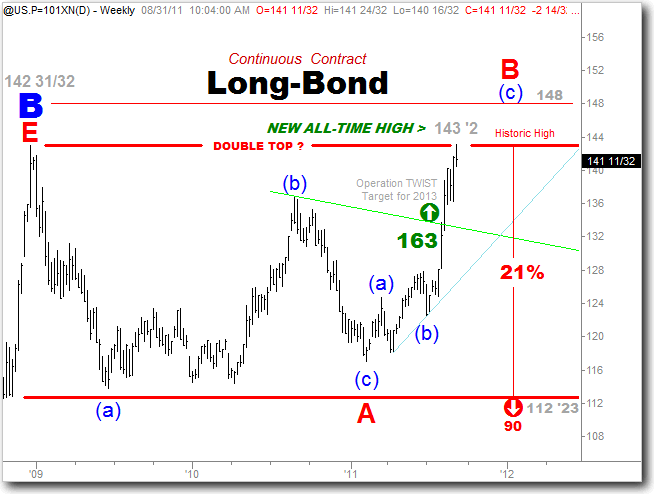Lately, there's been an awful lot of talk about a (ten-day) double top in Gold. In my view, a far better candidate to consider as approaching a prospective double top of epic proportion is the Long Bond.
In contrast to what may amount to nothing more than short-term volatility in the Gold market, Bonds have recently revisited an all-time price high not seen in three years.
Although there can be variations, the classic Double Top Reversal marks a prospective intermediate change, if not a long-term change in trend from bullish to bearish
At present, the Long Bond is at the earliest of plausible points in setting the stage for a potential Double Top of gargantuan proportion. Bear in mind that the Long Bond price can move to a new high of 148 and still be within the realm of a classic Double Top relative to its previous historic print high back in 2008.
Only time will tell if Bonds are approaching a top of import, or if Bernanke's Operation Twist and other Keynesian interventions will propel the Bond price toward the 163 target sometime in 2013.

ACTION ITEMS:
Bullish:Investors who believe that Bonds will do the Bernanke Twist might want to consider the following:
- Stay long the TLT. There is no doubt that Bonds have rewarded investors with great returns over the past 30-years however, no one ever went broke taking a profit. Taking 1/3 of your exposure off of the table at current levels may be prudent. If the Long Bond breaks above and sustains trade north of 148, it would greatly increase the chances of success for Uncle Ben's Operation Twist, and a push toward the 163 handle would then appear much more likely.
white space
Bearish:
Investors who believe that the recent retest of the historic high is a precursor to a large downside move in Long Bond prices may consider the following:
- Short the TLT or purchase (go long) an inverse Bond ETF. Barclays Capital Pro-Shares have a short 20+ Year Treasury ETF with the ticker symbol TBF, which is levered -1x the movement of bond prices. For those wanting twice the bang for the buck, they also have the Ultra Short TBT, which are levered -2x the bond price.
MORE ON DOUBLE TOP REVERSALS :
- Prior Trend: With any reversal pattern, there must be an existing trend to reverse. In the case of the Double Top Reversal, a significant uptrend of at least several months should be in place.
- First Peak : The first peak should mark the highest point of the current trend. As such, the first peak is fairly normal and the uptrend is not in jeopardy (or in question) at this time.
- Trough : After the first peak, a decline takes place that typically ranges from 10 to 20%. The lows are sometimes rounded or drawn out a bit, which can be a sign of tepid demand.
- Second Peak : The advance off the lows usually occurs with low volume and meets resistance from the previous high. Resistance from the previous high should be expected. Even after meeting resistance, only the possibility of a Double Top Reversal exists. The pattern still needs to be confirmed. The time period between peaks can vary from a few weeks to many months, with the norm being 1-3 months on daily chart or 1-3 years on a weekly chart. While exact peaks are preferable, there is some leeway. Usually a peak within 3% of the previous high is adequate.
- Decline from Peak : The subsequent decline from the second peak should witness an accelerated descent, perhaps marked with a gap or two. Such a decline shows that the forces of demand are weaker than supply and a support test is likely.
- Support Break : Even after trading down to support, the Double Top Reversal and trend reversal are still not complete. Breaking support from the lowest point between the peaks completes the Double Top Reversal.
- Support Turned Resistance : Broken support becomes potential resistance and there is sometimes a test of this newfound resistance level with a reaction rally. Such a test can offer a second chance to exit a position or initiate a short.
- Price Target : The distance from support break to peak can be subtracted from the support break for a price target. This would infer that the bigger the formation is, the larger the potential decline.
If you're still unsure of what to do about your exposure to Bonds, you can latch onto my strategic approach of engagement in three separate timeframes.
See you at my next action-packed market recap and update,
white space
~ ChartCaster
Chart-Caster is for those who wish to earn money using simple, easy-to-replicate trading strategies. In all timeframes and tradables (including ETFs and Futures), Chart-Caster covers 6 essential broad markets along with 5 of the most widely-held individual stocks. Chart-Caster delivers-the-goods on daily basis.
The Chart-Caster covers the following broad markets and individual stocks.
US DOLLAR | S&P-500 | NASDAQ-100 | GOLD | CRUDE OIL | BONDS
APPLE | GOOGLE | NETFLIX | AMAZON | CATERPILLAR
© 2025 Benzinga.com. Benzinga does not provide investment advice. All rights reserved.
Trade confidently with insights and alerts from analyst ratings, free reports and breaking news that affects the stocks you care about.